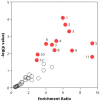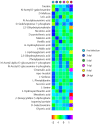A Time-Series Metabolomic Analysis of SARS-CoV-2 Infection in a Ferret Model
- PMID: 36422291
- PMCID: PMC9699618
- DOI: 10.3390/metabo12111151
A Time-Series Metabolomic Analysis of SARS-CoV-2 Infection in a Ferret Model
Abstract
The global threat of COVID-19 has led to an increased use of metabolomics to study SARS-CoV-2 infections in animals and humans. In spite of these efforts, however, understanding the metabolome of SARS-CoV-2 during an infection remains difficult and incomplete. In this study, metabolic responses to a SAS-CoV-2 challenge experiment were studied in nasal washes collected from an asymptomatic ferret model (n = 20) at different time points before and after infection using an LC-MS-based metabolomics approach. A multivariate analysis of the nasal wash metabolome data revealed several statistically significant features. Despite no effects of sex or interaction between sex and time on the time course of SARS-CoV-2 infection, 16 metabolites were significantly different at all time points post-infection. Among these altered metabolites, the relative abundance of taurine was elevated post-infection, which could be an indication of hepatotoxicity, while the accumulation of sialic acids could indicate SARS-CoV-2 invasion. Enrichment analysis identified several pathways influenced by SARS-CoV-2 infection. Of these, sugar, glycan, and amino acid metabolisms were the key altered pathways in the upper respiratory channel during infection. These findings provide some new insights into the progression of SARS-CoV-2 infection in ferrets at the metabolic level, which could be useful for the development of early clinical diagnosis tools and new or repurposed drug therapies.
Keywords: COVID19; SARS-CoV-2; animal models; ferret; host metabolic responses; metabolomics; omics.
Conflict of interest statement
The authors declare no conflict of interest.
Figures





References
-
- WHO Update 95-SARS: Chronology of a Serial Killer. [(accessed on 26 September 2022)]. Available online: https://www.who.int/emergencies/disease-outbreak-news/item/2003_07_04-en.
-
- WHO Summary of Probable SARS Cases with Onset of Illness from 1 November 2002 to 31 July 2003. [(accessed on 26 September 2022)]. Available online: https://www.who.int/publications/m/item/summary-of-probable-sars-cases-w....
-
- WHO Middle East Respiratory Syndrome Coronavirus (MERS-CoV) [(accessed on 26 September 2022)]. Available online: https://www.who.int/news-room/fact-sheets/detail/middle-east-respiratory...
-
- WHO Middle East Respiratory Syndrome Coronavirus (MERS-CoV)—Qatar. [(accessed on 26 September 2022)]. Available online: https://www.who.int/emergencies/disease-outbreak-news/item/2022-DON370.
-
- WHO Weekly Epidemiological Update on COVID-19—25 May 2022. [(accessed on 26 September 2022)]. Available online: https://www.who.int/publications/m/item/weekly-epidemiological-update-on....
Grants and funding
LinkOut - more resources
Full Text Sources
Miscellaneous

